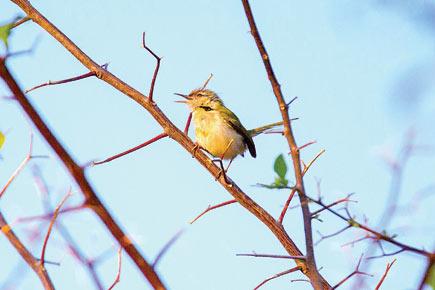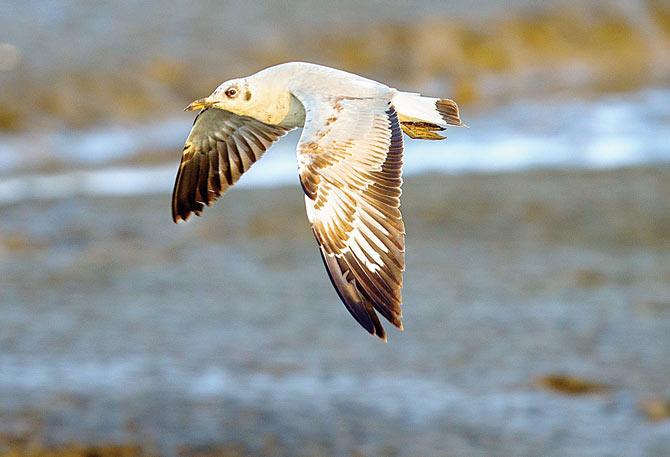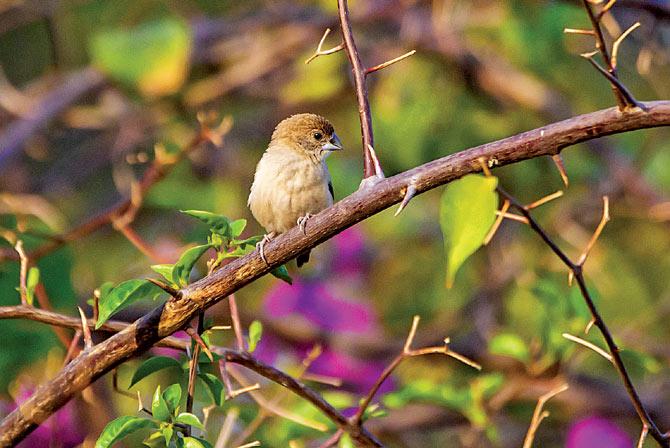A former bureaucrat and Delhi-based wildlife photographer shares stories surrounding the birds of South Mumbai whom he captured on a recent trip

 When one of the first things Vinod Goel says to us over coffee at a South Mumbai hotel, is, "I like to live in the present," you get why he'd rather introduce himself as wildlife photographer (although he doesn't pursue it professionally) than former bureaucrat.
When one of the first things Vinod Goel says to us over coffee at a South Mumbai hotel, is, "I like to live in the present," you get why he'd rather introduce himself as wildlife photographer (although he doesn't pursue it professionally) than former bureaucrat.
ADVERTISEMENT

Vinod Goel
Until January 2016, Delhi-based Goel, 60, served as a customs and excise service officer, and it was the luxury of time that retirement offered him, and a trip to Kanha National Park in 2004 that made him pick up the camera seriously. When we meet him, he is just back from a flamingo watching tour of Sewri Jetty, organised by his daughter and wildlife enthusiast, Nitya Goel. In a couple of hours, he will take a train to Delhi, but he "most certainly will squeeze in a couple of minutes to observe the gulls at Marine Drive". And so, he suggests we shift the venue of our interview to the promenade.
Braving the overhead sun, we walk the stretch and find a handful of gulls perched on the tetrapods. "You won't find too many at this hour," he says. "They are active from 8 am until 10 am. That's when visitors feed them chips and chivda." He admits that he is yet to figure their roosting hideout for the rest of the day.
In the last three weeks that Goel has been in Mumbai, he has divided his time between Hanging Garden (Malabar Hill), Sagar Upvan Park (Colaba), the Haji Ali promenade, the Byculla Zoo Marine Drive and Sewri jetty. He didn't set out with the intention of combing south Mumbai to observe birding activity. But luck introduced me to several avian varieties that I was surprised to find in the southern most tip of the megalopolis," he says.
It was an online article discussing the Purple-Rumped Sunbird that drew his attention to Mumbai. Here, he learnt that it could be spotted across various parks in the city. "It was a bird I hadn't seen in the 12 years I had been a photographer. I had to make a trip here."
Armed with a Canon 600 MM lens, Goel would start his day at 5 am and spend the latter part observing their behaviour. "You need patience when it comes to capturing birds. Before going on field, I usually spend time watching them, picking up behaviour cues, figuring how exactly I am going to get close enough to get a decent shot," he says.
In Delhi, Goel has spent three years capturing the life of the grey hornbill, right from courtship of adult pairs to the birth of young ones. For now, though, South Mumbai is his laboratory. He is already planning his next trip in the summer months to track the species that flood the city around that time.
Tailorbird
Found in: Deciduous forests, mangroves, open woodlands and gardens throughout India, except the desert
This frame shot at: Hanging Garden

It's measures 10-14 cm in length and has a long tail that it often holds upright. The upper plumage is green or grey while the underparts are shiny yellow white or grey. Normally built of cotton wool and grass stems, the nest of a tailor bird is not easy to spot. Tailorbirds are active when foraging for insects. Always hyper and restless, they are usually seen in pairs. The breeding season lasts from May to September.
Brown-Headed Gull
Found in: This is a small migratory Asian gull that breeds in the high plateaux of central Asia from Turkmenistan to Mongolia
This frame shot at: Marine Drive

They remain in Mumbai to breed until March, and later vacate the area for the high lakes of Ladakh. In the city, you are likely to spot them at Marine Drive in the mornings. They have a very wide ranging diet and feed on fish, shrimp, insects, slugs, worms and rodents. They also eat offal and are often seen at sewage farms. Sometimes, even plant material such as shoots and potatoes entice them.
Indian Silverbill
Found in: Pakistan, Nepal, Bangladesh, Iran and India. The Indian Silverbill inhabits dry, open, cultivated as well as sparse scrub-and-bush country. It avoids humid forests
This frame shot at: Hanging Garden

They feed on insects and have been known to visit nectar-bearing flowers. They are distinguished by their brown plumage, brownish-buff flanks and white rump. Like the sunbird, they roam in pairs and continue to raise their brood together year after year.
Purple- Rumped Sunbird
Found in: Sri Lanka, Bangladesh Meghalaya and Assam
This frame shot at: Sagar Upvan Garden, Colaba

Sunbirds are small, brightly coloured and have long curved beaks. You can identify the female by its yellowish throat. Mainly nectar feeders, they sometimes eat fruit and small insects when raising a family of young ones. I shot the male and female sucking nectar from the yellow trumpet flower at Sagar Upvan and Hanging Garden.
 Subscribe today by clicking the link and stay updated with the latest news!" Click here!
Subscribe today by clicking the link and stay updated with the latest news!" Click here!






